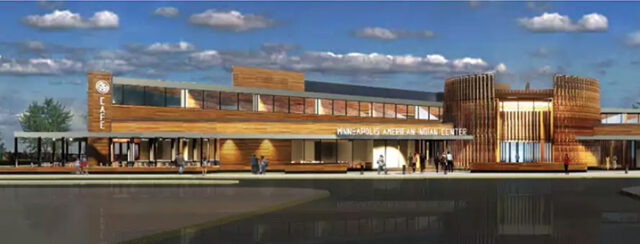
By Lee Egerstrom
The Minneapolis American Indian Center (MAIC) is among three community organizations selected to house solar power collectors and batteries to help their communities through times of power outages and natural disasters.
This is part of $9 million Resilient Minneapolis projects provided by the Minnesota Public Utilities Commission (PUC) that will have the community centers work as “islands” to serve neighboring communities when power is out.
Xcel Energy will install solar panels and batteries to create what are called microgrid systems at the three sites.
Mary LaGarde, MAIC’s executive director, said this project is an add-on, or an additional development, from the center’s $30 million renovation and expansion development that is targeted to launch later this fall.
In addition to the MAIC (1530 E. Franklin Ave.), microgrids systems will be created at Sabathani Community Center, 310 E. 38th St.; and by Renewable Energy Partners, a for-profit business partnering with Minneapolis Public Schools and University of Minnesota to build a North Minneapolis Community Resiliency Hub. It will have solar panels installed at Franklin Middle School, 1501 N. Aldrich Ave.; the schools’ nearby Nutrition Center, and Hall Elementary, 1601 N. Aldrich Ave.
In a statement issued by the city and Xcel Energy, the Resiliency Minneapolis projects were described as building backup power sources for key communities. The centers serve communities of Black, Indigenous and people of color who have been “disproportionately vulnerable to climate change and other stressors,” the statement said.
When power goes out, “people still need food and they still need power,” Mayor Jacob Frey said.
“So long as the sun comes up, solar panels will provide power – and our trusted community partners will provide food access, family support, and housing resources to our most vulnerable residents,” he said.
All three centers stressed the importance of green energy development and protection from disasters for their respective communities.
Jamez Staples, chief executive at Renewable Energy Partners, said the project will help the North Side community by protecting against power outages and at the same time provide teaching tools to help underserved community members become part of the clean energy economy.
Sabathani Community Center chief executive Scott Redd said converting to a resilience hub will also reduce carbon pollution and, “provide energy equity, wealth building, a healthy environment and workforce development in our predominately Black and brown communities.”
Those comments were echoed by Andrea Jenkins, Minneapolis City Council president. “We can take this opportunity to create a green jobs economy to address the equity gaps in our Black communities, Indigenous communities and communities of color.” This, she said, should help young people learn about green technologies and sustainable practices.
Up front, however, the three projects will provide surrounding neighborhoods with power support in times of emergencies. The importance of this planning has been shown nationwide by a series of severe natural disasters, often linked to climate change, and by other interferences that shut down local power and power grids.
When there are power outages, people still need gathering places to get warm, get food, or seek protection from excessive heat. The stored power in the batteries will also allow the centers to provide communications connections that are power-driven and of increased importance in this modern era.
This community development effort comes at a particularly fortuitous time for the Minneapolis American Indian Center and its nearby community in South Minneapolis, said executive director LaGarde.
The MAIC building is mostly closed at the present time and hopes to have everything in place to start its $30 million renovation and expansion project by signing initial construction contracts by mid-October, she said.
Fifth District Congresswoman Ilhan Omar, D-Minn., who represents Minneapolis, is scheduled to be at the center on Aug. 5 to present MAIC with a $3 million grant from the U.S. Department of Housing and Urban Development (HUD).
hat federal grant brings MAIC fundraising efforts up to $27 million, LaGarde said. The center’s officials and supporters are still working on finding the last remaining $3 million for the project.
It has been a tiresome effort, she said. Supply chain problems for building materials, other problems associated with costs inflicted by the COVID-19 pandemic and international instability, and now rising interest rates triggered by Federal Reserve Board’s efforts to combat inflation are all adding to the project’s costs.
Holding up fundraising, to some extent, was indecision by the Minnesota Legislature in choosing which programs and projects around the state it might help with appropriations from the state’s budget surplus. Those talks collapsed at the end of the session. Several large programs promoted by Native American groups, including MAIC renovation of Minneapolis center, were among ignored projects.
“I sure wish we got this project started earlier,” LaGarde said. “Everything has gotten more costly.”
Most offices have moved next door into space at the Many Rivers East complex, 1518 E. Franklin Ave. Only LaGarde and a few program administrators still work from offices in the building, and they, too, will soon move out for construction and renovations to begin.
The Gatherings Café is moving temporarily to nearby Little Earth of United Tribes facilities. It will no longer be a public café during construction, she said. But it will continue its catering business and continue preparing food for elderly and nutrition programs.
A big project in late July was wrapping up artworks at Two Rivers Gallery for long-term storage during construction.
Charley Stately, proprietor and owner of the Woodland Crafts Gift Shop that has operated in the MIAC basement, said he will be out of the basement – or first floor of the building – by Sept. 1. He, too, will relocate his shop to next door at the Many Rivers East building.
MAIC was constructed in 1975 and is regarded as one of the oldest, and largest, American Indian centers in the nation.
If construction with renovation goes according to plans, LaGarde said, the work should take about 18 months. That would allow reopening the center building in spring of 2024.






